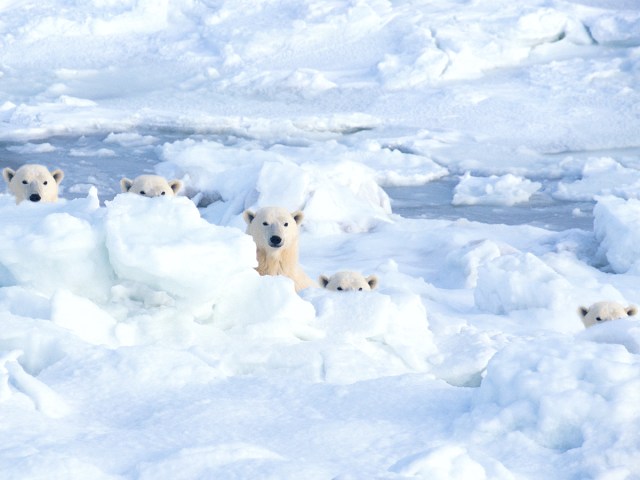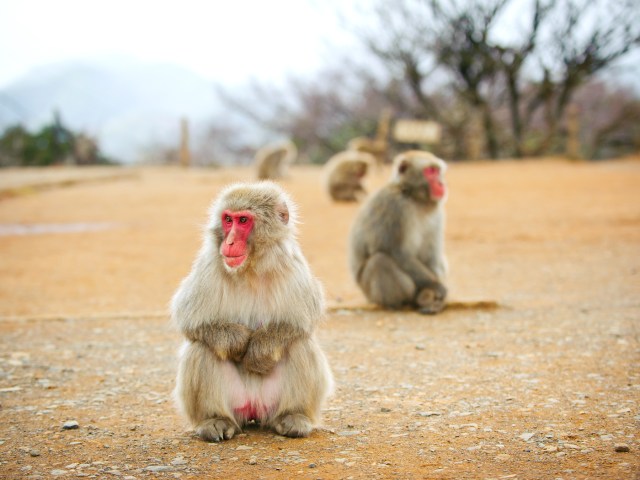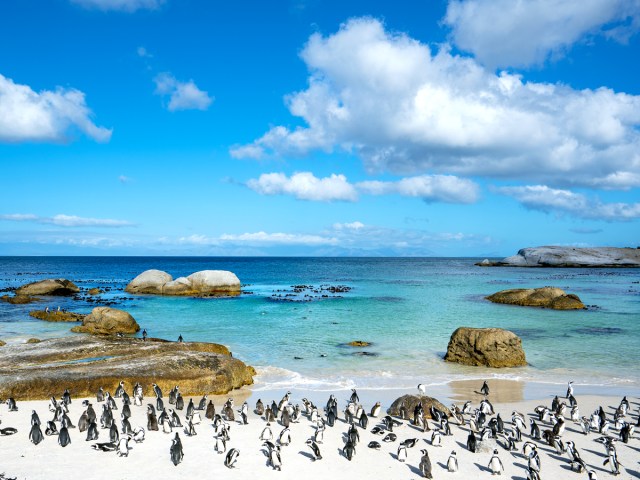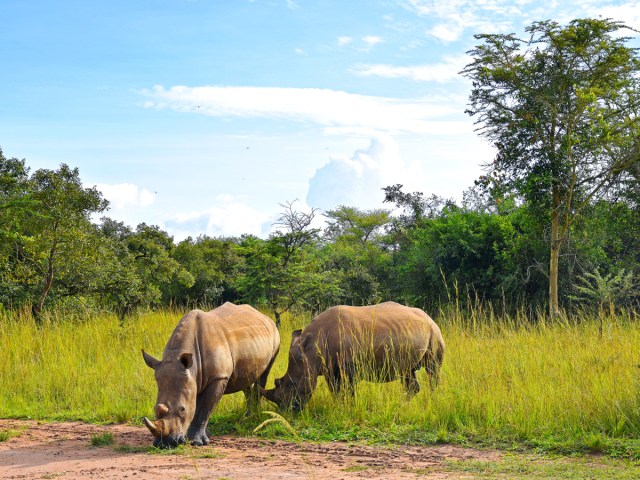Equally as stunning as the planet’s natural landscapes are the living creatures which inhabit them. Often, however, it’s only possible for travelers to experience wildlife from afar, and some fascinating species live in remote corners of the planet which few tourists will ever visit. Fortunately, there are a handful of special places where animal lovers can get an intimate view of wild creatures in their habitats. From the giraffes of Kenya to the polar bears of Canada, here are seven unique places where you can see wildlife up-close.
Churchill – Manitoba, Canada

Many travelers dream of the chance to see polar bears in the wild, but for most people, it remains just that — a dream. It’s a different story for the 900 or so residents of Churchill, Manitoba, who are quite used to catching sight of a polar bear strolling through town or even standing outside their bedroom windows at night. The prevalence of polar bears in this northern Canadian town has earned it the title of the “Polar Bear Capital of the World,” which in turn attracts thousands of tourists each year.
The bears spend the summer on land when the ice in Hudson Bay melts, and when they return to the water in the winter, their path often takes them right though downtown Churchill. During peak polar bear season in October and November, visitors can ride tundra buggies and get up close and personal with the curious bears, who have more or less acclimated to life around humans (and vice versa). Getting to Churchill is no small feat, however — it requires a chartered flight or a train ride across the permafrost. But for many, spending quality time with the world’s largest carnivores proves to be a once-in-a-lifetime opportunity.
Nara Park – Japan

Japan’s Nara Park draws crowds for many reasons, from exceptional flora to historic temples, but perhaps the most compelling is the chance to walk among the free-roaming sika deer population. The approximately 1,200 wild deer that roam the park, which are protected as natural monuments and are considered messengers of the gods in Shintoism. Visitors can feed the deer rice crackers called shika senbei, and the deer have been known to imitate a bowing motion in asking to be fed.
Nara Park was originally established in 1880, though the mammoth Todaiji wooden temple located on park grounds was constructed in 752 and houses a 50-foot-tall bronze Buddah statue. The park is home to six other temples, including the vermilion-colored Kasuga Taisha Shrine, famous for its wisteria flowers that bloom each May. Visitors can also view spectacular Buddhist art at the park’s Nara National Museum or attend the Wakakusa Yamayaki — a local festival held on the fourth Saturday in January in which the dead grasses of the adjacent Mount Wakakusayama are burnt in an awe-inspiring display that lights up the sky.
Manatee Springs State Park – Florida

Along the Suwannee River, just south of the point where Florida’s Panhandle meets the rest of the state, prodigious Manatee Springs gushes about 100 million gallons of fresh water each day. But in winter, the spring’s temperate waters — a steady 72 degrees Fahrenheit year-round — attract West Indian manatees as the Gulf waters turn chilly. The manatees venture into the Suwannee River and then swim 23 miles upstream to arrive at the comfortable mainspring pool, where they stay through March.
For more than 10,000 years, humans have come here, too. The spring is now surrounded by a state park, with eight miles of trails that wind through leafy forests, past sinkhole ponds, and over boardwalks across cypress swamps. Kayaking, canoeing, and swimming are permitted in Manatee Springs itself, as well as along the quarter-mile-long spring run that connects it to the Suwannee River. While scuba divers are not permitted in the mainspring, they compete for a limited number of permits to explore the extensive cave system that runs under the length of the spring, all the way to the river.
Arashiyama Monkey Park – Kyoto, Japan

In bustling Kyoto, less than an hour from the city’s central rail station, is an opportunity to witness Japan’s adorable “snow monkeys.” Endemic to the country, Japanese macaques are most famously photographed lounging in the hot springs five hours north, in the more remote region of Nagano. But at Arashiyama, visitors need only take a 20-minute cherry tree-lined hike up from the base of Mount Iwata to Monkey Park Iwatayama to interact with around 150 of these wild creatures.
At the park’s designated feeding area, you can purchase fruit and nuts to feed the appreciative monkeys (who will likely try to snatch the treats from your hands). While they interact freely with visitors, the monkeys are wild and should be respected. If you visit in spring and summer, you’ll also have an opportunity to see baby macaques being tended by their mothers. The mountaintop park — which has great views of Kyoto and its surroundings — is open throughout the year and has a small playground, a snack bar, and viewing platforms to take in the scenery.
Giraffe Manor – Nairobi, Kenya

Travelers to Kenya, many of them eager to get to a safari camp, may not immediately understand why an overnight stay in the Nairobi suburbs is recommended. But anyone who loves animals will want to hightail it to this one-of-a-kind hotel that shares its grounds with a private giraffe sanctuary. The giraffes freely wander the property, snacking on the ivy that grows on the buildings, nibbling bushes in the garden, and sidling up to the terrace wall during afternoon tea to get treats. Perhaps most spectacularly, they’ll sometimes even stick their heads through open breakfast room windows to greet diners.
The 1930s house, built as a private home, was bought in 1974 by a couple dedicated to conserving endangered wildlife. They rescued five Rothschild giraffes and built the adjacent Giraffe Centre to begin a breeding program to save them from the edge of extinction. In 1983, the elegant house was converted to a hotel. Animal lovers soon began to arrive in earnest, and viral vacation photos of the giraffes mingling with hotel guests continue to ensure that bookings will continue — especially as long as there are long necks and gentle faces nosing through the dining room windows.
Boulders Beach – South Africa

Boulders Beach — named for the massive rocks that protect this inlet on False Bay from the rough currents of the South Atlantic Ocean — should have probably been renamed Penguin Beach instead. In 1985, two breeding pairs of penguins took up residence here, playing the role of penguin pioneers on this beautiful beach, which has since become a protected colony. Boulders Beach is now visited annually by around 2,200 endangered African penguins mostly between the months of February and August.
The black-footed residents, who grow up to around 28 inches tall, swim and waddle freely on the sand and rocks of Boulders Beach, protected from wild land-based predators by the surrounding village of Simons Town. The birds will venture up into the streets, sidewalks, and parking lots of Simons Town and make their nests under houses and in gardens. Alas, town life is not without its perils for the penguins. Locals are warned to check under their parked cars before driving. But humans who come to see the penguin colony at the north end of Boulders Beach are restricted to boardwalk viewing of the residents. (The south end of the beach is open to human sunbathing and swimming.)
Ziwa Rhino Sanctuary – Uganda

Rhinos once roamed throughout the East African country of Uganda, but sadly, many species were hunted to near the point of extinction by the early 1980s. The Ziwa Rhino & Wildlife Ranch is a sanctuary dedicated to righting past wrongs, as it seeks to restore Uganda’s once-thriving rhinoceros population. Today, the refuge is the only place in Uganda where tourists can view wild rhinos in their natural habitat. Opened in 2005 with just four rhinos donated from neighboring Kenya and two from Disneyland, the sanctuary (a former cattle ranch) has since seen their endangered rhino population grow to 33. The ultimate goal is for the animal to be reintroduced into the Ugandan wilderness.
The sanctuary is located in Uganda’s Murchison Falls National Park, which is also home to the powerful Murchison Falls. In addition to rhinos, Ziwa Ranch hosts a wide array of mammals, ranging from leopards to aardvarks and even some hippopotami. The sanctuary is also considered a birdwatching mecca, containing over 350 species of birds — including the striking large-bodied shoebill stork, which can be spotted during early morning canoe safaris through the preserve’s Lugogo Swamp.
More from our network
Daily Passport is part of Inbox Studio, which publishes content that uplifts, informs, and inspires.
















